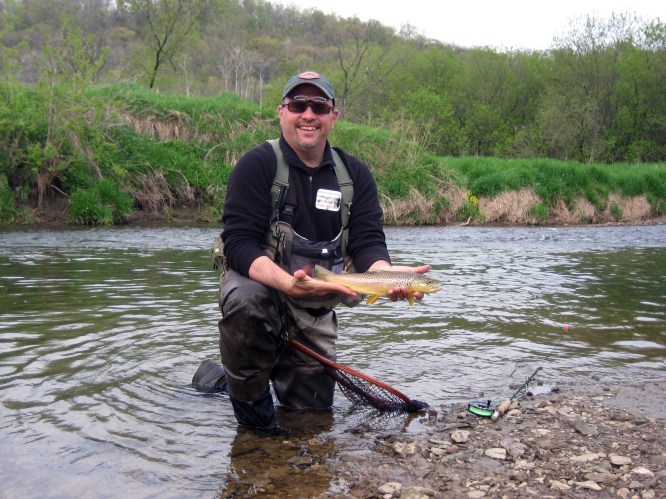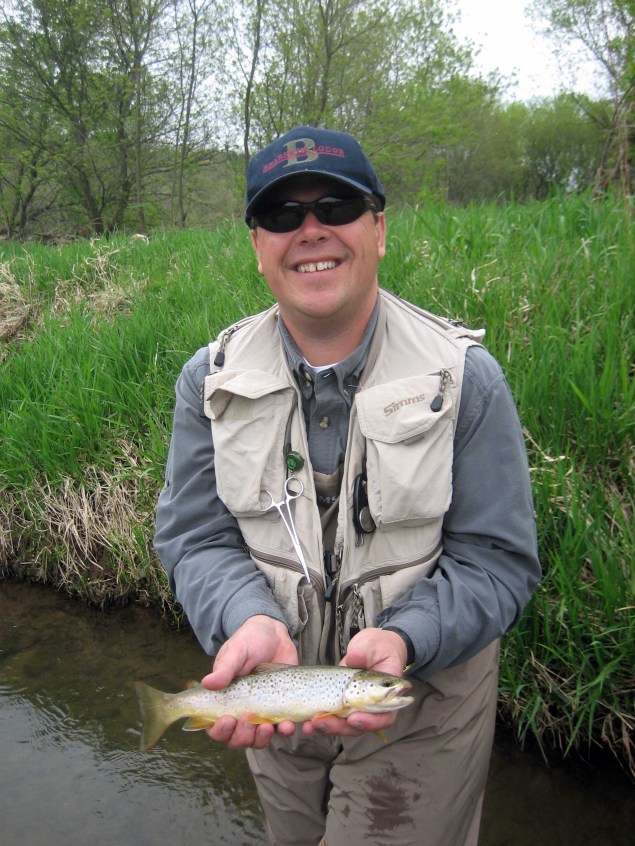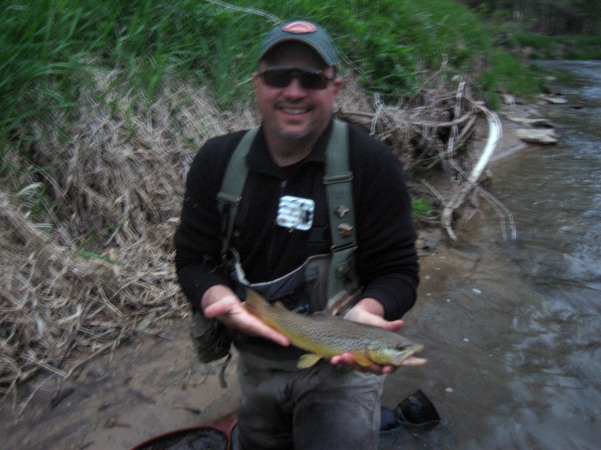Planes are steadily coming and going from the General Mitchell International Airport in Milwaukee, Wisconsin. The FJ is parked outside of baggage claim for only a short time when Ingemar emerges, bags in hand. Ing and I have known each other for about 8 years. We worked for the same company in different cities back in the late 90’s. However, it wasn’t until the aftermath of the dot-com bust in 2001 that we were thrust in front of each other as we fought to get a fledgling company off the ground. We immediately hit it off. We both approach work and play with the same intensity, passion, and resolve. Life eventually took our careers in different directions; but we stayed connected through our fishing – making occasional treks in late March for Michigan steelhead on famous rivers like the Rogue, the Manistee and the Pere Marquette. In all that time, we never fished my home waters, so I feel pretty damn good about heading out with Ing for a couple days to a favorite spot or two.
We are headed for Vernon County: a county that sits right in the middle of the “driftless area” and is host to hundreds of miles of trout streams. “Driftless” refers to the lack of glacial drift meaning the material that gets left behind by retreating glaciers. Hundreds of thousands of years ago, this area was spared one last pounding by the driving nature of glacial drift. The Wisconsin Glacial Episode was the last major advance of ice in the region, and its retreat started far to the north of this area. Being spared helped to preserve deep valleys, high limestone bluffs and the perfect chemical make-up for some of the best trout streams in the world.

Driftless Region
http://en.wikipedia.org/wiki/Driftless_Area
Ingemar always introduces me to local fly-shops during our forays in Michigan, so our first stop is a fly fishing shop in Viroqua called The Driftless Angler. Mat Wagner is the owner. Mat left his Rocky Mountain paradise in the winter of 2006/07 to pursue a new paradise right here in Wisconsin: The Driftless Area. He opened his shop in February of 2007 and has never looked back. Mat maintains a fishing report for the area. . The person tending the shop is very helpful, but tells us that the river we came to fish has been pretty off this past week. Caddis seem to be the fare though, so we grab a few extra bugs from the shop and head for the river.
It is pushing almost 5 p.m. when we finally get to the river – those of you that have fished with me know that spot. We step into a bend and face up stream. Above us is a deep, right-angle corner in the river that pours water through a riffle into a fast, short run that terminates in a pool at our feet. We have our caddis flies in tow, but having fished here for years, I rig up with a black stone fly #10 and trail it with a #14 prince nymph. The length of leader between the bugs and my poly strike indicator is about 8 feet to start.
Ing watches intently as I complete the setup and then offers me first cast so that he can see how I fish this rig. I am two casts into the lower part of the run when a fish takes. I play him out in the softer water below – a fat, 13-inch brown! Not bad for kicking things off.

Bead-Head Stonefly With Zug Bug Dropper
This first fish makes me realize that I left my net back in the truck. Yes, I am a net man. I can land fish without a net, but after years of this habit I prefer to net my fish. This stretch has produced some bruisers in the past so I head back to the truck to grab us a couple of nets. When I return, Ing informs me that he has had couple of nice fish here and one that got off. He is a true gentleman and offers me another shot at the run before we move up. I decide to move down a little, cross the river and approach from a different angle. This affords me the ability to drop my rig close to the top of the run and get a pretty good drift down the long seam that heads into the pool. On my third, consecutive drift a fish strikes hard and heads for a spot deep in the bottom of the pool. It is a heavier fish than the first one and it takes me a bit to coax it down stream. I finally land him and he is a solid 15-inches. It is another nice brown trout. Ing grabs a camera and snaps of a nice photo before we release him back to the depths.

Vernon County Brown Trout
We are both enthused by this bigger trout and continue to work our way toward the head of the pool for “the big dog”. We never raise a fish at the head of the pool, but you should always work that spot hard. It is a prime spot for big fish.
Next we approach the deep water above this spot. There is a fish rising at the head this next pool, so we immediately switch to a #14 elk hair caddis and go after him. Several drifts do not raise the fish. After a few more casts, he rises again. We mark the location. The next cast is spot-on, but the hook set is too quick and the fish is only stung. He is gone.
A couple of bends up, there is a reputed hole where water rushes down a literal drop-off and into a partially submerged tree. Below the tree the river forms a nice pool. Further down is a large, sub-surface timber that lies across the river. We draw nearer, using this log to mark our approach and never moving closer than within a few feet of it. I am already rigged up for this spot, so I hand my rod to Ing. After a few casts, he is into a respectable, fat brown trout and he lands it.

Satisfied Angler!
I ask him “do you want the good news or the bad news.”
He replies “give me the good.”
“You just caught a nice little brown trout.”
“Then there is no bad news!” he quips.
“The bad news is that it’s my turn at this hole now!” Ing hands the rod back to me and I check the fly. I notice an abrasion about 6 inches up the line. I don’t want to risk losing a big fish so I decide to retie the rig. It is a good idea to check your line often, especially after playing a fish. Since I had to re-tie anyway, I moved to a more heavily weighted fly. The water here is very fast and I want to make sure the fly is getting down quickly. I am rewarded with another nice brown –
There is some friendly banter over whether the fly change was a known recipe for success here. I toss the rod back to Ingemar and remind him that I am not his gillie today! We both laugh as he works another fish. We continue to take turns extracting fish from the pool by working the seams on either side. Wonderful. The river is “on” like I have seldom seen it before. Ing is getting spoiled by one of my favorite Wisconsin streams.

Deep Run, Big Brown
Evening is sneaking up on us so we hustle up to a spot where a spring comes in and the colder water holds some nice brook trout. We switch to bead-head prince nymphs and start swinging the flies down and across. Just like below, I am demonstrating the technique to Ingemar when a fish strikes right away. It is a female brook trout. We rig both rods the same way and I move up river a bit to give Ing some room. He strikes a nice fish a few casts later and I come back down to photograph a beautiful male brook trout – his first.

Ingemar’s Square Tail in Full Colors
I head back up river again and this time I notice a large, flat boulder with a nice pocket right below it. I stay well across river from the spot, but position myself about 15 yards upstream as well. I work out some line and start my down and across swing. I continue to lengthen my line until there is enough to swing my fly right through the pocket, exposing only the leader to the slower water in the pocket. Thump! I feel the fish and set the hook. He leaps into the air and runs down toward Ing. It is another nice brown trout. The light is falling so the picture is a little fuzzy, but I had to include it – the biggest trout of the day.

Twilight Trout
May 26, 2012 at 6:49 am
[…] that. Wisconsin is well known as the premier blue ribbon trout fishery in the Midwest. Bar none. The driftless area, however, is not bounded by state lines. It is an area defined by geology. Southwest Wisconsin, […]